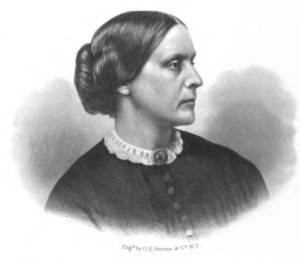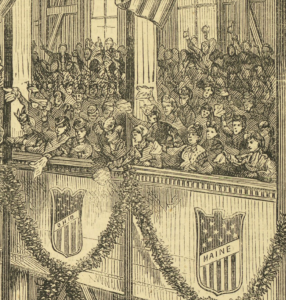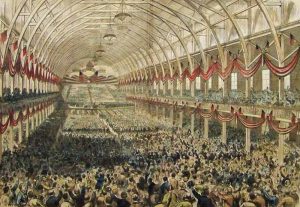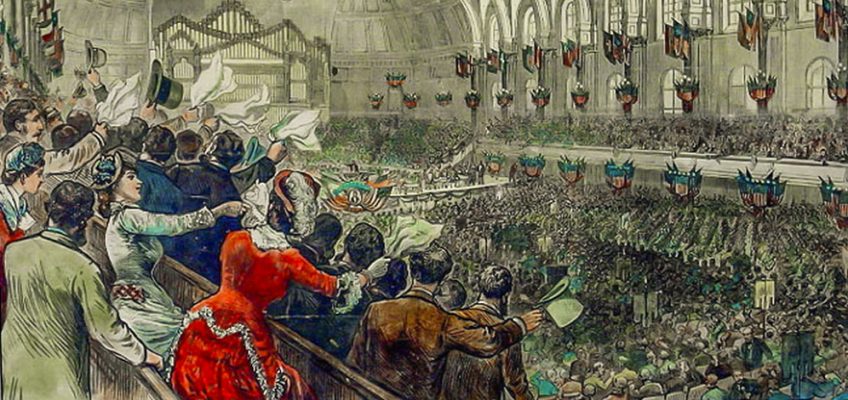By Thea Tjepkema

Susan B. Anthony and other prominent suffragists spent decades fighting for the women’s national right to vote. The National Woman Suffrage Association (NWSA) led the charge from 1869-1890 for a constitutional amendment. Pounding the pavement — or cobblestones — for the cause, brought Anthony and other prominent women to Cincinnati to read impassioned pleas at three different political conventions in two iconic halls on the same site in Over-the-Rhine.
On This Site: Susan B. Anthony’s Spirit Lives
Saengerhalle was built in 1870, on the site where Music Hall stands today. A venue for choral festivals and conventions it was soon expanded for industrial expositions and became popularly known as Exposition Hall. It was demolished in 1876 to make way for the construction of Music Hall’s central building.
In January of 1878, the Susan B. Anthony Amendment, guaranteeing the national right for women to vote, was first introduced in Congress. In May of the same year, Cincinnati Music Hall opened.
The nineteenth amendment to the Constitution was not ratified until 1920, 42 years later, using the same words as Anthony’s original draft. In 1872, 1876, and 1880, she and others valiantly advanced their resolutions from these Cincinnati stages.

1872 Liberal Republican Party National Convention: Exposition Hall
On the first three days in May of 1872, the Liberal Republican Party held its only national convention at Exposition Hall in Cincinnati. This short-lived party opposed the reelection of President Ulysses S. Grant and threatened to split the Republican Party.

The NWSA sent Anthony and Laura de Force Gordon to this convention to petition delegates to hear their woman’s suffrage resolution and to add it to the new party’s platform. Gordon sought to represent California as a delegate in the Convention, but the Committee on Credentials refused.
However, she and Anthony were invited with others to be “tendered the courtesy of the hall.” Anthony and Gordon were granted seats on the stage, but their resolution was not read aloud. Frank Leslie’s Illustrated Newspaper reported that when they were escorted onto the stage the audience rose and gave them a “good-humored cheer” while the band played “Come to the Gypsy Camp” with “general hilarity.”
Setting the Stage
On the first day a crowd of 7,000 attended, with nearly 400 seated on the stage. Decorations included shields for every State in the Union lining the panels of the galleries looped with evergreen garland.
The triple stages for German musical choruses were decked with silk flags and patriotic emblems. A large effigy of a spread-eagle at the rear of the stage hung above the Cincinnati coat-of-arms and a painting of the Muse of History loomed in the rear gable.

The ladies’ gallery was initially closed off, but when opened it quickly filled. The evening session of the second day saw even greater attendance with 2,000 ladies present.
How Women Were Often Viewed
Frank G. Welch, an attendee, wrote a humorist book, That Convention or Five Days a Politician, giving a clear idea of how many men felt toward the suffragists at the time. He slanders Gordon and Anthony, stating they were only allowed to serve at the convention as “things of beauty.” However, he called Anthony the “Colonel” and under her illustration wrote, “Warranted to travel anywhere without fear of molestation.”
While Anthony “represented the aggressive female American brains,” he dubbed Gordon the “Reverend,” and suggested she “personified the beauty of strong-mindedness.”

The Cincinnati Enquirer’s report of the convention also focused on the appearance of Mrs. Gordon: “plucky, good looking, and as full of the spirit of progress as possible … ought to have a seat at the Convention for these qualities if for nothing else.”
The newspaper further reported that Anthony and Gordon spoke to delegates later in the evening in the parlor of the Burnet House when the police were called. Welch’s account said the “proprietors of the Burnet were very kind to the boys — much kinder than they were to the girls and walked them out under escort.”Nevertheless, Anthony and Gordon Persisted
Despite the failure to be heard in Cincinnati at the 1872 Convention, Anthony and Gordon attended the Republican National Convention in Philadelphia a month later, where Ulysses S. Grant was nominated for re-election. The History of Woman Suffrage stated, “the fruit of all our earnest labor of this delegation was a splinter in the Republican platform.”
Some pleasure was taken at the first mention of women in the platform of either of the great political parties, even though it was in a simple symbolic statement of the party’s “obligation to the loyal women of America … her demands for additional rights should be treated with respectful consideration.” The suffragists were disappointed, but they saw some promise for the future:
We see in it the thin edge of the entering wedge which shall break woman’s slavery
in pieces and make us, at last, a nation truly free —
a nation in which the caste of sex shall fall down by the caste of color,
and humanity alone shall be the criterion of all human rights.
1876 Republican National Convention: Exposition Hall

The 1876 Republican National Convention was held in Cincinnati, June 14 to 16, at Exposition Hall. According to the History of Woman Suffrage, the NWSA sent delegates Sara Andrews Spencer and Elizabeth Boynton Harbert to address the Committee on Platforms. Spencer was permitted to address the Convention.
On the second day of the Convention, 6,000 people filled Exposition Hall including a “slight sprinkling of female attire” brightening the gallery and seats at the rear of the stage for wives of delegates, observed the Enquirer. Abolitionist Frederick Douglass, a guest, thanked the crowd for emancipation but asked for protection of African American men heading to the ballot box, especially in the South.
After the opening prayer, by Rev. George B. Beecher, George F. Hoar, a delegate from Massachusetts, proposed the Convention attendees listen to the “memorial of a large class of our citizens, who are excluded from any representation here, or from any share in the government.” Susan B. Anthony’s document had been delivered to the Committee on Resolutions, but Spencer was given just ten minutes to read it. According to the Enquirer, the delegates voted whether to listen to Mrs. Spencer and the motion, “was carried, against decided dissent, with a chorus of cat-calls.”
The Enquirer reporter did not describe what Spencer read but criticized her looks, as “sharp-featured, acidulous — without distinction in any respect whatever — commonplace in appearance and speech; and, when she had spoken her little speech without anything in it she wafted herself back to the handiest seat, and that was the end of the incident … and woman suffrage was perhaps just where it was before; for she did not convince enemies, she did not please friends, and she disgusted the indifferent.” He concluded, judgmentally, “It is true that a woman of genius cannot always be beautiful — but then Mrs. Spencer was not a woman of genius; and one or the other, genius or beauty, is indispensable in the advocate of such a cause.”
At this convention, the Republican Party only adopted a “recognition” plank, mentioning “with approval the substantial advance recently made toward the establishment of equal rights for women … The honest demands of this class of citizens for additional rights, privileges and immunities should be treated with respectful consideration.” The convention eventually nominated Ohio Governor Rutherford B. Hayes, who was elected America’s nineteenth president.
1880 Democratic National Convention: Cincinnati Music Hall
In 1880 the NWSA sent delegates to the conventions of four parties: Republican, Democrat, Greenback, and Prohibition.
Anthony led 76 members to the Republican convention in Chicago, June 2-8, which nominated James Garfield. They were not well received, nor did they succeed in getting their resolution on the Republican platform. Therefore, the NWSA declared it would refuse to support any party unless
its platform … [would] emphatically endorse our demand for a recognition of the exact and permanent political equality of all citizens.
Twenty NWSA delegates from eleven different states came to Cincinnati for the 1880 Democratic National Convention held in Music Hall from June 22 to 24. Major-General Winfield Hancock of Pennsylvania was nominated for the presidency; he was defeated by Garfield in November. The NWSA women were treated more civilly in Cincinnati, where they received a committee room in Music Hall, printed placards pointing to their headquarters, and 16 reserved seats on the floor of the convention, just behind the regular delegates. First on the suffragists’ agenda was to get approval from the Committee on Resolutions for their plank to be added to the proceedings and then voted on for addition to the Democratic platform.

The convention proceedings state that Susan B. Anthony, Matilda Joslyn Gage, Lillie Deveraux Blake, and Elizabeth Meriwether all spoke, with no time limit, at a hearing before the Committee on Resolutions in Music Hall. At the close of this meeting, many delegates favored their plank:
That the Democratic party, recognizing the rapid growth of the woman suffrage question, suggests consideration of this important subject by the people in anticipation of the time, near at hand, when it must become a political issue.
Nevertheless, no result was reached, likely due to the objections of Southern delegates who feared the political recognition of African American women. Despite the failure to act, delegations from Maine, Kansas, and New York offered the NWSA representatives the use of their committee rooms at the Burnet House and the Grand Hotel. Mayor Frederick Prince of Boston secured seats for the women delegates on the floor of the house for the Convention. Mayor Carter Harrison of Chicago assured them he would do his best to help them be heard before the Convention and offered to escort Miss Anthony to the platform to present their resolution written by Matilda Josyln Gage.

On the first day of the Convention, many women filled Music Hall’s north and south side galleries. Blue silk banners edged in gold, bearing the names of different states indicated the positions of the delegates on the floor. Bunting decorated the windows and a blue canvas hung from the center of the ceiling proclaimed, “Ohio Greets the Nation.” At 2 p.m. that day the Committee on Resolutions went to meet in designated rooms at the rear of the stage only to find suffragists had taken over their space. The Cincinnati Daily Star reported, just as the Committee was “about to proceed to business, they discovered Hon. Susan B. Anthony demurely sitting in their midst and ready to help engraft a woman’s suffrage plank into the National platform. The Committee was too chivalrous to notify Miss Anthony that a session was an executive one, and so, without a word, just as silently as the Arab folds his tent, they gathered themselves together and filed off into another room, leaving their uninvited guest to her whereases and her umbrella.”
The next day’s Enquirer reported that the committee had met at 9 p.m. the night before at the Grand Hotel, in the rooms of the Iowa delegation, where “Colonel Susan B. Anthony and some of her ancient dames appeared and asked to inject a plank in the platform. Miss Meriwether … undertook to read, but forced by palpitation…the Colonel, after trying to boost her, had to read them herself.” The committee reported the women of NWSA “eloquently pleaded their cause but retired without receiving any assurances of the adoption of the desired plank.”
On the second day, Wednesday, June 23, a long list of distinguished women — wives of governors, senators, and delegates, as well as prominent Cincinnatians such as Maria Longworth Nichols and Louisa Torrey Taft — filled seats on the stage, “…like diamonds in a jeweled box,” according to the Enquirer. The Daily Star reported a band played national airs as state delegations entered and struck up “Yankee Doodle” when the NWSA delegates arrived with immense cheering. The women distributed circulars with their platform printed on them. On the floor, the Enquirer mentioned, “some of the most distinguished delegates came over to the seats occupied by the suffrage ladies and expressed sympathy for their cause.”
On June 24, according to the Star after the band played “Auld Lang Syne,” accompanied by Music Hall’s immense organ, Susan B. Anthony came up the aisle, and the cheering “was like the voice of thunder.” She presented a circular to the chair and asked to insert a plank drawn up by the Woman’s Suffrage Society. The Enquirer reported that Mayor Harrison from Chicago spoke up for Anthony and escorted her onto the stage, as he had promised backstage the day before. However, chairman Wade Hampton of South Carolina offered her a seat and ordered the clerk to read the address. After the clerk read the “long rigmarole … the delegates listened in respectful silence, but not one was found to move its insertion in the platform, there was faint applause, and Susan sighed.”
It would be another 40 years until women were granted the right to vote by the nineteenth amendment to the U.S. Constitution, which was ratified on August 18, 1920.
Thea Tjepkema is a member of the Friends of Music Hall Board of Directors as historic preservationist, content curator, and archivist.
Illustration credits
01: Interior of Exposition Hall decorated with state shields and evergreen garland on galleries. 1872 Liberal Republican Party Convention, by James E. Taylor, Frank Leslie’s Illustrated, May 18, 1872.
02: Laura de Force Gordon and Susan B. Anthony being escorted by Theo. Tilton to seats on Exposition Hall stage. 1872 Liberal Republican Party Convention, by Matt Morgan, Frank Leslie’s Illustrated, May 18, 1872.
03: Detail of ladies in north gallery of Exposition Hall decorated with Ohio state shield. 1872 Liberal Republican Party Convention, by James E. Taylor, Frank Leslie’s Illustrated, May 18, 1872.
04: Interior Exposition Hall decorated with flags. 1876 Republican National Convention, by James E. Taylor, Frank Leslie’s Illustrated, July 1, 1876.
05: Women in the gallery of Cincinnati Music Hall. 1880 Democratic National Convention, by Joseph B. Beale, Frank Leslie’s Illustrated, July 3, 1880.
Portrait engravings in the History of Woman Suffrage Vol. 1 & 3: Anthony, Gordon, Gage, Blake, Meriwether.
Suffragists delegates listed in Music Hall in Enquirer: Susan B. Anthony, Matilda Joslyn Gage, and Lillie Devereux Blake, NY; Sara Andrews Spencer, D.C.; Elizabeth A. Meriwether, TN; Rachel and daughter, Julia Foster, PA; Elizabeth L. Saxon, LA; Endie J. Polk, MO; Mrs. Cunningham, MA; Mrs. W.R. Allen, IA; Mrs. E.T. Charles, IN; Mrs. Wolcott and Miss Trimble, KY; Mrs. A.B. Merriam and Mrs. Thomas Campbell, OH.
References:
Official Proceedings of the National Republican Conventions of 1868, 1872, 1876, and 1880. Charles W. Johnson, Pub., 1903.
Stanton, Elizabeth Cady, Susan B. Anthony, and Matilda Joslyn Gage, eds. History of Woman Suffrage, Vol. III, 1876-1885. Rochester, New York, Charles Mann Printing Co., 1886, pp. 181-183.
Welch, Frank G., et al. That Convention or Five Days a Politician. New York and Chicago, F.G. Welch & Co., Pub., 1872.

